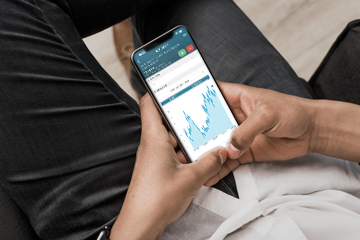Make an impact with your Keyprivate

Keytrade Bank
keytradebank.be
May 10, 2023
5 minutes to read
Not everyone has the time, interest or knowledge to get hands-on with investing. That’s why we launched Keyprivate in 2016. Which investments should you buy/sell? At what price? When? ... You hand over all the homework to a team of stock market experts: they invest part of your assets in line with your own preferences.
People, environment and society
From now on, our experts will not only take into account your personal choices in terms of risk, potential return, your investment horizon, etc. If you want them to, they will also take into account your sustainability preferences.
In simple terms, if you sign up for our asset management at Keytrade Bank, we now ask you not just 'How much risk do you want to take and for how long do you want to invest?' but also 'How green or sustainable does your portfolio need to be?' If you want to invest part of your portfolio in sustainable investments, let us know your sustainability preferences. If you are not interested in this, don't use this option and select the (classic) Keyprivate.
“With Keyprivate you invest in a selection of trackers; with saying yes to the extra option of sustainability preferences you invest mainly in sustainable trackers”, explains Geert Van Herck (Chief Strategist, Keyprivate). "Trackers are budget-friendly products that invest in dozens or hundreds of shares or bonds in one fell swoop. Sustainable trackers do exactly the same thing, but they only invest in companies which care about their impact on people, the environment and society."
Strict, stricter, strictest
"Sustainable" is a label that can cover a multitude of things. "A Keyprivate with 'sustainable preferences' only invests in trackers that follow an EU Paris-aligned Benchmark and/or the Green Bond Principles" explains Olus Kayacan (Sustainable Investment Expert at Keytrade Bank). "That may not sound so sexy, but that is what it boils down to. The first case means that the companies in which the tracker invests work within the framework of the Paris Climate Agreement. The tracker is built up in such a way that the emissions from the companies in which it invests do not exceed the thresholds of the climate agreement. The Green Bond Principles are guidelines that define which bonds can be considered green."
Spread + diversification
The new approach allows you to invest across a variety of markets and asset classes. "In practice they use sustainable regional equity trackers in the broad American market, Europe, Japan and emerging countries. For bonds, they use green bonds. These bonds are earmarked for use only to finance green investments, such as wind farms, public bicycle infrastructure, etc.", explains Geert Van Herck. "We will not be investing in thematic trackers in things such as renewable energy or electric vehicles because of the risk posed by increased concentration. Of course, these areas are represented in our sustainable regional equity trackers."
Democratic entry barrier and low costs
While most banks only allow you to opt for asset management (they invest for you) from a level of either EUR 100,000 or EUR 250,000, with Keyprivate you can do so from as little as EUR 15,000. Not only is the entry threshold democratic, the rates are too. "This is because we work with trackers rather than investment funds. Unlike a fund, a tracker does not have a full team of analysts behind the scenes," Olus Kayacan explains. "A tracker simply follows an index. That makes it much cheaper. The management fee for Keyprivate is 0.91% per annum. This includes both VAT and transaction costs. And is 2 to 3 times less than what a traditional asset manager charges."
Return on sustainable investments
Sustainable investment or not: potential returns remain just as important. "In the long term, sustainable investments should not perform less well than traditional investments. Although there are of course events that may cause the situation to shift in the future," says Geert Van Herck. "Growth shares – which are often heavily represented in sustainable portfolios – have been buoyant for years. However, thanks to the change in central banks' policy (raising interest rates) and the changed economic outlook, these shares have been underperforming recently. But because the major megatrends (climate change, digitalisation, changing demographics, etc.) are and will continue to be relevant, sustainable investment remains so too."
Decide for yourself how sustainable your portfolio will be
The EU aims to be the first carbon neutral continent by 2050. To make this possible, the EU is also relying on investors. The EU would like to see less capital flowing into polluting business activities, and more capital flowing into companies focusing on sustainable development. That is why Europe also requires a sustainability facet to be included in each investor profile. Anyone who buys shares, funds, trackers, etc. independently does not need to take any notice of this. But those who choose to have part of their assets managed for them, or who receive investment advice from their bank, will see some changes.
In the latter case, banks are now obliged to ask you about your sustainability preferences. “This is also true if you opt for Keyprivate,” explains Olus Kayacan. "Using a short questionnaire, Keytrade Bank can prepare an investment proposal for you that is in line with both your risk appetite and your sustainability preferences. In this way, the EU wants to make investors think more consciously about the impact of their portfolio."

